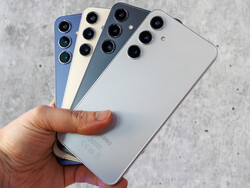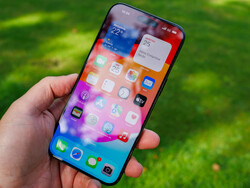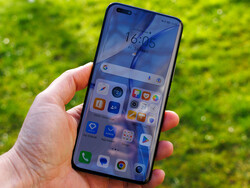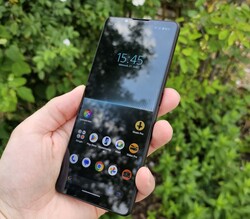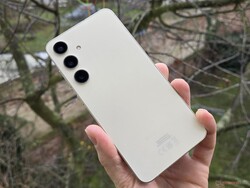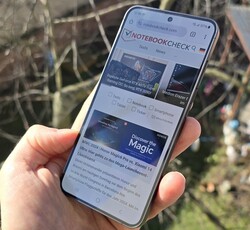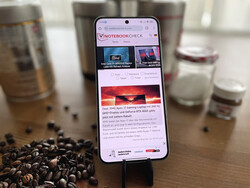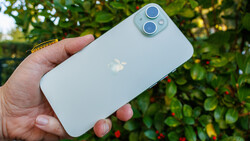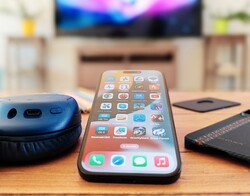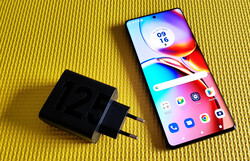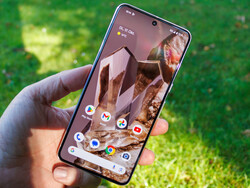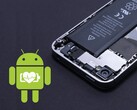The Best Smartphones
Besides the ranking of the high-end smartphones, the following charts might be interesting as well:
Smartphones are destroying everything else in terms of sales in the mobile market. These incredibly versatile devices outstripped normal cell phones ages ago. With even stronger processors and growing display sizes, the so-called "phablets" are now encroaching on tablet territory. The line between these devices is growing increasingly blurry - at least at the upper end of the market. These smartphone-tablet crossbreeds have taken many of the top spots in our smartphone Top 10 list. As a result, most of the top models in our list are occupied by very recently released devices. Still, here and there a brave old soldier has clung on to the top of the ladder.
The Best Smartphones
Position | Total Rating | Date | Image | Model | Height | Weight | Size | Refresh-Rate | Resolution | Screen-to-Body | OS |
|---|---|---|---|---|---|---|---|---|---|---|---|
| 1 | 91.1 % | 03/2024 New! | 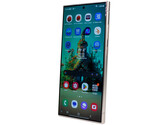 | Samsung Galaxy S24 Ultra Qualcomm Snapdragon 8 Gen 3 for Galaxy Qualcomm Adreno 750 12 GB Memory, 256 GB | 8.6 mm | 232 g | 6.80" | 120 Hz | 3120x1440 | 89 % | Android 14 |
| 2 | 91.1 % | 12/2023 |  | Apple iPhone 15 Pro Max Apple A17 Pro Apple A17 Pro GPU 8 GB Memory, 256 GB NVMe | 8.25 mm | 221 g | 6.70" | 120 Hz | 2796x1290 | 88 % | Apple iOS 17 |
| 3 | 90.1 % | 07/2023 | 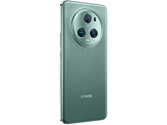 | Honor Magic5 Pro Qualcomm Snapdragon 8 Gen 2 Qualcomm Adreno 740 12 GB Memory, 512 GB | 8.77 mm | 219 g | 6.81" | 120 Hz | 2848x1312 | 91 % | Android 13 |
| 4 | 89.9 % | 06/2023 | 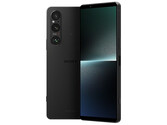 | Sony Xperia 1 V Qualcomm Snapdragon 8 Gen 2 Qualcomm Adreno 740 12 GB Memory, 256 GB | 8.3 mm | 187 g | 6.50" | 120 Hz | 3840x1644 | 84.2 % | Android 13 |
| 5 | 89.8 % | 03/2024 New! | 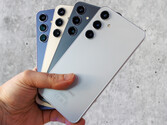 | Samsung Galaxy S24+ Samsung Exynos 2400 Samsung Xclipse 940 12 GB Memory, 512 GB | 7.7 mm | 196 g | 6.70" | 120 Hz | 3120x1440 | 92 % | Android 14 |
| 6 | 89.8 % | 01/2024 New! | 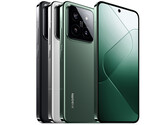 | Xiaomi 14 Qualcomm Snapdragon 8 Gen 3 Qualcomm Adreno 750 12 GB Memory, 256 GB | 8.2 mm | 193 g | 6.36" | 120 Hz | 2670x1200 | 89 % | Android 14 |
| 7 | 89.7 % | 11/2023 |  | Apple iPhone 15 Plus Apple A16 Bionic Apple A16 GPU 5-Core 6 GB Memory, 128 GB NVMe | 7.8 mm | 201 g | 6.70" | 060 Hz | 2796x1290 | 88 % | Apple iOS 17 |
| 8 | 89.7 % | 06/2023 | 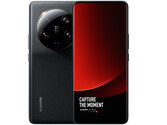 | Xiaomi 13 Ultra Qualcomm Snapdragon 8 Gen 2 Qualcomm Adreno 740 12 GB Memory, 512 GB | 9.1 mm | 227 g | 6.73" | 120 Hz | 3200x1440 | 89.5 % | Android 13 |
| 9 | 89.4 % | 05/2023 | 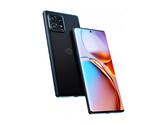 | Motorola Edge 40 Pro Qualcomm Snapdragon 8 Gen 2 Qualcomm Adreno 740 12 GB Memory, 256 GB | 8.6 mm | 199 g | 6.67" | 165 Hz | 2400x1080 | 91 % | Android 13 |
| 10 | 89 % | 12/2023 New! | Google Pixel 8 Pro Google Tensor G3 ARM Mali-G715 MP7 12 GB Memory, 128 GB | 8.8 mm | 213 g | 6.70" | 120 Hz | 2992x1344 | 87 % | Android 14 |
The table above contains an overview over the best smartphones reviewed by Notebookcheck over the course of the past 12 months as well as still relevant and available older products. In cases of identical score the more recent device is listed first. All prices in above table and price comparisons are updated daily and can thus differ.
Link: all devices in this class reviewed
Editors' Comments
There are four newcomers this month, including a new number 1. These all displace their predecessors, with the Xiaomi 14 replacing the Xiaomi 14 Pro, as the latter is not available globally. The Vivo X100 Pro was narrowly defeated and the Oppo Find X7 Ultra and the Honor Magic6 Pro are further promising candidates in our review.
1st - Samsung Galaxy S24 Ultra
The Samsung Galaxy S24 Ultra offers a 6.8-inch AMOLED display, which impresses with its high pixel density and high refresh rate. It is powered by a Snapdragon 8 Gen 3 for Galaxy with 12 GB of RAM. There is a choice of 256, 512 or 1,024 GB of internal memory. Samsung also offers dual SIM (also dual eSIM), IP68 certification, a large 5,000 mAh battery, UWB and an S Pen integrated into the casing.
The Galaxy S24 Ultra is a first-class smartphone, even though Samsung primarily focuses on fine-tuning.
Samsung not only provides many new AI functions, but also a full seven years of updates. The quad camera on the back offers very good imaging performance, but has only been given a really new look. I have to criticize Samsung for the calibration of the display, which is still really good, but it could be better in the high-end range. The cooling of the SoC is also rather mediocre.
The Samsung Galaxy S24 Ultra is available among others Amazon, with prices starting just North of $1,150 for the 256 GB SKU.
Pricecompare
2nd – Apple iPhone 15 Pro Max
The Apple iPhone 15 Pro Max is slightly slimmer than its predecessor and, above all, noticeably lighter. This is mainly due to the titanium alloy of the new frame. Apple is also saying goodbye to the Lightning port and integrating USB-C instead.
The display is a 6.7-inch OLED panel with a refresh rate of up to 120 Hz, a high resolution and Dolby Vision support. With the largest battery in an iPhone, the runtimes are also correspondingly long.
The iPhone 15 Pro Max is an all-round successful smartphone. Even if it has to put up with a lot of malice for the late switch to USB-C, it is still very well done.
There have also been changes to the camera: the main camera once again uses a 48 MPix sensor, which now generates 24 MPix images. A new feature is the optical zoom, which now offers five times the magnification and can rely on a brand new stabilization system. The iPhone 15 Pro is slightly smaller and has a weaker zoom lens.
The iPhone 15 Pro Max can be purchased directly from Apple in all color and storage variants.
Pricecompare
3rd – Honor Magic5 Pro
The Honor Magic5 Pro is a powerful high-end smartphone with an impressive triple camera, a large battery, fast charging, 3D facial recognition, and a long update supply. It uses the Snapdragon 8 Gen 2 processor with 12 GB of RAM and 512 GB of storage.
The Honor Magic5 Pro is a very good Android smartphone that only allows itself a few weaknesses.
The case is well-made and waterproof. It has a fast USB 3.2 port, but does not support UWB. The smartphone comes with Google Android 13 and the MagicOS 7.1 user interface. The cameras offer good results in both photos and videos. The communication features are modern, but the smartphone does not support 6 GHz WLAN. It has good navigation features and offers good telephony quality. The quite extensive scope of delivery should also be emphasized positively. Overall, the Honor Magic5 Pro is a powerful smartphone with minor limitations.
The Honor Magic5 Pro is not available in the US.
Pricecompare
4th – Sony Xperia 1 V
The Sony Xperia 1 V offers a slim 21:9 display with an enormously high resolution and a peak brightness of up to 1,566 cd/m². A fast SoC from Qualcomm is just as much a part of the equipment as a water- and dust-proof casing, but its display-surface ratio looks a bit old-fashioned. In return, the wider bezel accommodates really good speakers and the Xperia 1 V can also accommodate an optional memory card. An audio jack also adorns the equipment list.
Sony's Xperia 1 V is a really good smartphone and can score with features that other manufacturers have already shelved.
The Sony Xperia 1 V is available through Sony's online store as well as the usual retail channels, such as Amazon US.
Pricecompare
5th – Samsung Galaxy S24 and S24+
The Samsung Galaxy S24+ is visually very similar to its compact sibling, the Galaxy S24, and is only slightly larger. However, there are other differences on the inside: the Galaxy S24 Plus has a larger OLED display with a higher WQHD+ resolution, a larger battery, 4 GB more RAM and an ultra-wideband chip. In Europe, both are powered by a modern Exynos SoC, which, however, is not as efficient as the Snapdragon in the Ultra model.
The Samsung Galaxy S24+ offers a strong overall package with seven years of updates. The Galaxy S24 is more compact, but also has to make compromises in terms of features.
Both Galaxy smartphones can boast IP68 certification, wireless charging, tri-band Wi-Fi, dual SIM (incl. eSIM), many new AI functions and an identical triple camera. Unfortunately, the latter has only received software-side improvements, but still takes good photos and benefits from the new Galaxy AI. However, it is a shame that neither supports Bluetooth 5.4 or Wi-Fi 7.
The Galaxy smartphones can be ordered directly from Samsung, but are also available from all common online retailers like Amazon.
Pricecompare
6th – Xiaomi 14
The Xiaomi 14 is the Chinese company's most compact high-end smartphone. It has a 6.36-inch OLED display with a high pixel density and a refresh rate of up to 120 Hz. It is powered by a fast Snapdragon SoC and has 12 GB of RAM. There is a choice of 256 or 512 GB of memory. In addition to USB 3.2, IP68 certification, fast charging with 90 watts and eSIM support are also available.
The Xiaomi 14 is a powerhouse with a good Leica camera.
A highlight of the Xiaomi 14 is the triple camera, which was developed in cooperation with Leica. It not only offers three high-resolution sensors, but also good image quality and many setting options. Unfortunately, the second nano SIM can only be replaced by an eSIM; dual eSIM is not possible. UWB is also not available.
The Xiaomi 14 can be found via Xiaomi's web store. Otherwise, user can purchase the smartphone via Amazon US.
Pricecompare
7th – Apple iPhone 15 and iPhone 15 Plus
While the iPhone 15 has a 6.1-inch display, the iPhone 15 Plus has a 6.7-inch display. Accordingly, the batteries are also different in size at 3,349 mAh and 4,383 mAh respectively. And that's it for the differences.
Both iPhones are powered by a fast SoC and have access to 6 GB of RAM. There is a choice of 128, 256 or 512 GB of memory. The dual camera relies on a 48 MPix sensor, which is designed to enable a dual, almost lossless digital zoom and is supplemented by an ultra-wide-angle lens. The Apple smartphones are equipped with MagSafe, UWB and wireless charging and are protected against dust and water in accordance with IP68.
The iPhone 15 models are characterized by excellent workmanship, long battery life, a good dual camera and bright display, but we also miss some features that are otherwise common in this price range.
In the review, both iPhones were convincing, but also had to put up with criticism for the fact that, among other things, the display only works at 60 Hz, only slow USB 2.0 is installed and no 6 GHz WLAN is supported.
Both iPhones can be purchased is available directly from Apple, but can also be purchased from Amazon US for around $930.
Pricecompare
8th - Xiaomi 13 Ultra
The Xiaomi 13 Ultra just throws superlatives around. The 6.73-inch AMOLED display is supposed to be able to get up to 2,600 cd/m² brightness, but this was not confirmed in our test. The camera setup is based on a Sony IMX989 and was developed in cooperation with Leica. Fast charging with up to 90 watts and a lot of memory are also included.
The Xiaomi 13 Ultra leaves hardly anything to be desired, but it also has a steep price.
The Xiaomi 13 Ultra does not really have to put up with much criticism. However, despite the great specs, the smartphone is not the spearhead in terms of photography and the front-facing camera does not support Ultra HD video despite its massive resolution. It is also anything but lightweight at 227 grams. However, fans of the manufacturer will get their money's worth.
Currently, the device is available as an import device from TradingShenzhen, prices starting around $1,185.
Pricecompare
9th – Motorola Edge 40 Pro
The Edge 40 Pro is lightweight and compact and offers high-end features, including 12GB of RAM and 256GB of storage. It features a USB-C port with USB 3.2 speed, NFC for wireless payments, and support for an eSIM profile. The Motorola smartphone comes with Android 13, and Motorola has assured that it will receive future updates. However, the security patches were outdated at the time of review.
Motorola Edge 40 Pro shines with a strong price-performance ratio.
The Edge 40 Pro offers good camera quality with a 50-megapixel main camera, a wide-angle lens and an optical zoom for close-ups. The OLED display is bright and can display HDR content well, although it is not outstanding in terms of resolution and luminosity. The speakers deliver good sound, and the phone has a variety of Bluetooth audio codecs.
The battery has a capacity of 4,600 mAh and offers good runtimes. The phone supports fast charging. Overall, the Motorola Edge 40 Pro offers a good total package at a relatively low price.
At the time of writing, the Edge Pro 40 only appears to be available in Europe.
Pricecompare
10th – Google Pixel 8 Pro
The Google Pixel 8 Pro has a 6.7-inch OLED display with a high pixel density of 490 PPI. The LTPO function allows the system to dynamically adjust the refresh rate between 1 and 120 Hz. The smartphone is powered by Google's own SoC, which can draw on 12 GB of RAM. The battery has a capacity of 5,050 mAh and wireless charging is supported. The Pixel phone is also dust and waterproof in accordance with IP68.
The Google Pixel 8 Pro is a great high-end smartphone with a good camera and long update supply.
The Pixel 8 Pro proves to be quite complete in the test and also has USB 3.2, a temperature sensor, UWB and Wi-Fi 7 on board. The triple camera also takes really good pictures. Unfortunately, the USB port does not support wired image output and the memory is comparatively slow.
Interested users can buy the Pixel 8 Pro directly from the Google Store, but it is also available from other retailers, Amazon, for example.
Pricecompare
Best Smartphones in Comparison
Test Results
| Samsung Galaxy S24 Ultra Adreno 750, SD 8 Gen 3 for Galaxy, 256 GB UFS 4.0 Flash | Apple iPhone 15 Pro Max A17 Pro GPU, A17 Pro, 256 GB NVMe | Honor Magic5 Pro Adreno 740, SD 8 Gen 2, 512 GB UFS 4.0 Flash | Sony Xperia 1 V Adreno 740, SD 8 Gen 2, 256 GB UFS 4.0 Flash | Samsung Galaxy S24+ Xclipse 940, Exynos 2400, 512 GB UFS 4.0 Flash | Samsung Galaxy S24 Xclipse 940, Exynos 2400, 256 GB UFS 4.0 Flash | Xiaomi 14 Adreno 750, SD 8 Gen 3, 256 GB UFS 4.0 Flash | Apple iPhone 15 Plus A16 GPU 5-Core, A16, 128 GB NVMe | Xiaomi 13 Ultra Adreno 740, SD 8 Gen 2, 512 GB UFS 4.0 Flash | Motorola Edge 40 Pro Adreno 740, SD 8 Gen 2, 256 GB UFS 4.0 Flash | Google Pixel 8 Pro Mali-G715 MP7, Tensor G3, 128 GB UFS 3.1 Flash | |
|---|---|---|---|---|---|---|---|---|---|---|---|
| Response Times | |||||||||||
| Response Time Grey 50% / Grey 80% * | 3.8 ? | 1.58 ? | 0.87 ? | 1.54 ? | 2.8 ? | 2.57 ? | 1.11 ? | 3.26 ? | 1.02 ? | 1.1 ? | 1.85 ? |
| Response Time Black / White * | 1.41 ? | 0.88 ? | 1.18 ? | 0.93 ? | 1.12 ? | 1.09 ? | 1.54 ? | 1.83 ? | 1.04 ? | 1.1 ? | 1.07 ? |
| PWM Frequency | 480 | 240 | 120 | 376 | 479 | 483 | 429 | 60 | 120 | 235 | 120 |
| Screen | |||||||||||
| Brightness middle | 1317 | 1102 | 1291 | 934 | 1358 | 1349 | 1043 | 1044 | 1357 | 1056 | 1510 |
| Brightness | 1365 | 1102 | 1289 | 948 | 1358 | 1369 | 1052 | 1040 | 1340 | 1055 | 1467 |
| Brightness Distribution | 94 | 98 | 96 | 96 | 92 | 97 | 96 | 99 | 89 | 92 | 92 |
| Black Level * | |||||||||||
| Colorchecker dE 2000 * | 3.4 | 1.1 | 1.7 | 1.5 | 3 | 3.3 | 1.1 | 1.2 | 1.1 | 1.28 | 1.1 |
| Colorchecker dE 2000 max. * | 5 | 3.1 | 4.4 | 4 | 4.4 | 5 | 2.8 | 2.4 | 2.7 | 2.85 | 3.8 |
| Greyscale dE 2000 * | 2.8 | 1.6 | 2.9 | 1.3 | 2.5 | 2.4 | 1.9 | 2.1 | 2 | 1.7 | 1.7 |
| Gamma | 2 110% | 2.19 100% | 2.28 96% | 2.2 100% | 1.98 111% | 1.97 112% | 2.23 99% | 2.14 103% | 2.2 100% | 2.206 100% | 2.23 99% |
| CCT | 6458 101% | 6555 99% | 6472 100% | 6384 102% | 6656 98% | 6635 98% | 6740 96% | 6411 101% | 6366 102% | 6320 103% | 6670 97% |
| Heat | |||||||||||
| Maximum Upper Side * | 44.1 | 45.8 | 34 | 44.6 | 49.5 | 43.4 | 44.2 | 38.4 | 48.4 | 46.8 | 43 |
| Maximum Bottom * | 45.8 | 45.2 | 31.6 | 44.3 | 48.1 | 44 | 41.3 | 39.5 | 46.8 | 46.1 | 43.8 |
| Idle Upper Side * | 26.6 | 34.6 | 34 | 32.8 | 25.6 | 26.3 | 27.4 | 30.5 | 31.2 | 22.6 | 28.3 |
| Idle Bottom * | 26.3 | 33.2 | 29.1 | 28.2 | 25.5 | 26.2 | 27.1 | 28.1 | 29.7 | 23 | 27.1 |
| Battery Runtime | |||||||||||
| Reader / Idle | 2227 | 3514 | 2580 | 1321 | 2398 | 2926 | 2480 | 1729 | 2102 | 1344 | |
| H.264 | 1922 | 2013 | 1249 | 859 | 1227 | 1674 | 1585 | 1010 | 1062 | 1122 | |
| WiFi v1.3 | 1148 | 1163 | 1074 | 743 | 1009 | 880 | 1092 | 1102 | 1065 | 984 | 760 |
| Load | 202 | 384 | 276 | 159 | 277 | 336 | 298 | 297 | 220 | ||
| Power Consumption | |||||||||||
| Idle Minimum * | 0.73 | 0.5 | 0.91 | 1.52 | 0.43 | 0.42 | 0.51 | 0.71 | 0.86 | 0.7 | 0.63 |
| Idle Average * | 1.22 | 1.97 | 1.63 | 2.16 | 0.84 | 0.93 | 0.89 | 2.09 | 1.53 | 0.8 | 1.47 |
| Idle Maximum * | 1.34 | 1.99 | 1.67 | 2.2 | 0.95 | 1.07 | 0.92 | 2.11 | 1.64 | 1.3 | 1.55 |
| Load Average * | 16.52 | 3.36 | 2.61 | 7.85 | 6.76 | 15.43 | 9.08 | 4.32 | 3.12 | 10 | 8.45 |
| Load Maximum * | 16.58 | 10.43 | 4.57 | 11.57 | 16.42 | 16.51 | 9.11 | 6.25 | 6.5 | 13.7 | 8.63 |
* ... smaller is better
Benchmarks
| Antutu v9 - Total Score (sort by value) | |
| Samsung Galaxy S24 Ultra | |
| Honor Magic5 Pro | |
| Xiaomi 14 | |
| Xiaomi 13 Ultra | |
| Motorola Edge 40 Pro | |
| Google Pixel 8 Pro | |
| Basemark ES 3.1 / Metal - offscreen Overall Score (sort by value) | |
| Apple iPhone 15 Pro Max | |
| Samsung Galaxy S24+ | |
| Samsung Galaxy S24 | |
| Apple iPhone 15 Plus | |
| UL Procyon AI Inference for Android - Overall Score NNAPI (sort by value) | |
| Samsung Galaxy S24 Ultra | |
| Honor Magic5 Pro | |
| Samsung Galaxy S24+ | |
| Samsung Galaxy S24 | |
| Xiaomi 14 | |
| Xiaomi 13 Ultra | |
| Motorola Edge 40 Pro | |
| Google Pixel 8 Pro | |


 Deutsch
Deutsch English
English Español
Español Français
Français Italiano
Italiano Nederlands
Nederlands Polski
Polski Português
Português Русский
Русский Türkçe
Türkçe Svenska
Svenska Chinese
Chinese Magyar
Magyar

